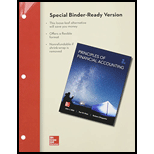
Concept explainers
Perpetual: Alternative cost flows P1
Ming Company uses a perpetual inventory system. It entered into the following purchases and sales transactions for April. (For specific identification, the April 9 sale consisted of 8 units from beginning inventory and 27 units from the April 6 purchase; the April 30 sale consisted of 12 units from beginning inventory, 3 units from the April 6 purchase, and 10 units from the April 25 purchase.)
| Date | Activities | Units Acquired at Cost | Units Sold at Retail |
| Apr. 1 | Beginning inventory | 20 units # $3,000.00 per unit | |
| Apr. 6 | Purchase | 30 units @ $3,500.00 per unit | |
| Apr. 9 | Sales | 35 units & $12,000.00 per unit | |
| Apr. 17 | Purchase | 5 units $4,500.00 per unit | |
| Apr. 25 | Purchase | 10 units @ $4,800.00 per unit | |
| Apr. 30 | Sales | 25 units 4 $14,000.00 per unit | |
| Total | 65 units | 60 units | |
Required
1. Compute cost of goods available for sale and the number of units available for sale.
2. Compute the number of units in ending inventory.
3. Compute the cost assigned to ending inventory using (a) FIFO, (b) LIFO, (c) weighted average, and (d) specific identification. (Round all amounts to cents.)
4. Compute gross profit earned by the company for each of the four costing methods in part 3.
Problem 6-2BA
Periodic: Alternative cost flows P3
Refer to the information in Problem 6-lB and assume the periodic inventory system is used.
Required
1. Compute cost of goods available for sale and the number of units available for sale.
2. Compute the number of units in ending inventory.
3. Compute the cost assigned to ending inventory using (a) FIFO, (b) LIFO, (c) weighted average, and (d) specific identification. (Round all amounts to cents.)
4. Compute gross profit earned by the company for each of the four costing methods in part 3.
Want to see the full answer?
Check out a sample textbook solution
Chapter 6 Solutions
Principles of Financial Accounting, Chapters 1-17 - With Access (Looseleaf)
- Principles of Accounting Volume 1AccountingISBN:9781947172685Author:OpenStaxPublisher:OpenStax College
 College Accounting, Chapters 1-27AccountingISBN:9781337794756Author:HEINTZ, James A.Publisher:Cengage Learning,
College Accounting, Chapters 1-27AccountingISBN:9781337794756Author:HEINTZ, James A.Publisher:Cengage Learning, Financial And Managerial AccountingAccountingISBN:9781337902663Author:WARREN, Carl S.Publisher:Cengage Learning,
Financial And Managerial AccountingAccountingISBN:9781337902663Author:WARREN, Carl S.Publisher:Cengage Learning,  Financial Accounting: The Impact on Decision Make...AccountingISBN:9781305654174Author:Gary A. Porter, Curtis L. NortonPublisher:Cengage Learning
Financial Accounting: The Impact on Decision Make...AccountingISBN:9781305654174Author:Gary A. Porter, Curtis L. NortonPublisher:Cengage Learning Financial AccountingAccountingISBN:9781305088436Author:Carl Warren, Jim Reeve, Jonathan DuchacPublisher:Cengage Learning
Financial AccountingAccountingISBN:9781305088436Author:Carl Warren, Jim Reeve, Jonathan DuchacPublisher:Cengage Learning Survey of Accounting (Accounting I)AccountingISBN:9781305961883Author:Carl WarrenPublisher:Cengage Learning
Survey of Accounting (Accounting I)AccountingISBN:9781305961883Author:Carl WarrenPublisher:Cengage Learning





